Dan Adkins (March 15, 1937 – May 3, 2013)
by J. David Spurlock with Tim Lasiuta
—
Dan Adkins was a fun, colorful character who, despite many years in the New York area, never lost his colloquial country accent. Starting with Wallace Wood, whom Dan Adkins admired and worked under beginning with T.H.U.N.D.E.R Agents in 1965, Adkins’ rise led him to collaborate with many talents such as John Buscema, Barry Windsor-Smith, Jack Kirby, Jim Steranko, Rich Buckler, Don Newton, Steve Ditko, Herb Trimpe, Gene Colan, Paul Gulacy and Gil Kane.
A versatile talent, Dan Adkins wrote, penciled, painted and inked for Marvel Comics, Gold Key/Western Publishing, Warren Publishing, DC and Tower Comics from 1965 until his passing at the age of 76 in 2013. Along with Wallace Wood and Bill Pearson, he also pioneered as a fanzine publisher. Adkins served as an Art Director at Marvel and as a consultant to friends like Jim Steranko as well as mentoring a new generation of artists which included Val Mayerik, Paul Gulacy and P. Craig Russell.
BEGINNINGS:
Adkins was born Danny Lee Adkins, March 15, 1937 in Midkiff, West Virginia and later moved to Pennsylvania when he was around seven years old. Other stops along the way included Reno, Nevada; Phoenix, Arizona; New York City/Brooklyn, Ohio, New Jersey and Reading PA where he spent his later years.
His youth was spent reading comic books, a habit which increased greatly when he contracted rheumatic fever at the age of 11. Temporarily paralyzed from the waist down, he voraciously read comics like Curley Kayo and Fred Harmon’s Red Ryder. After his recovery, as a teenager, he discovered E.C. Comics which, introduced him to the revolutionary work of Wallace Wood.
In an interview in Alter Ego, Adkins told Roy Thomas: “I got in [to reading EC Comics] around Weird Fantasy #11 or 12, just when they really started getting good… I liked Williamson and Davis and Crandall and Evans… all the top guys were my top guys. [But Wood was paramount]; we’d be looking for Wally Wood covers at the drugstore in our home town every Tuesday and Thursday; when the comics used to come in. I wasn’t into DC Comics or super-heroes at that time. [But,] later on, I got into Kirby.”
1950s: FROM AIR FORCE to SCIENCE FICTION & FANZINES:
As Steven Ringgenberg reported in his Comics Journal obituary on Adkins, after graduation from high school, Dan joined the Air Force and worked as a draftsman at Luke Field, in Phoenix, Arizona. His duties included updating blueprints, illustrating electronic schematics and design changes. As part of his duties, he also created posters for the base library and movie theater in addition to a monthly magazine of upcoming events. It was there that Adkins launched the fanzine Sata in 1956. Adkins’ science-fiction fanzine was produced on the base’s mimeograph machine. In an Alter Ego Interview, Adkins told Thomas that: “As an illustrator, I had a whole room to myself with equipment to turn out posters to put in front of the base library and movie theatre. We also did a magazine where we’d list all the happenings. We had to spend a certain amount of money per month in order to get the same amount the next month. And I couldn’t come up with enough things to spend the money on, so I started a fanzine! The Air Force paid for Sata.”
Adkins had met Bill Pearson through a letter he had published in Amazing Stories. “He was a shy guy, who really didn’t want to meet anybody,” said Adkins in CBA. “But we shared a love of science fiction and fanzines.” Pearson joined the staff of Sata and eventually became editor after issue six; a gig which lasted until issue thirteen.
1960s: GOING PRO IN THE BIG APPLE
Around the same time, as Pearson took over Sata, Adkins married Janette Strouse and they moved to New York. There he met Archie Goodwin, Frank Frazetta, Steve Ditko and Al Williamson and began to work with various magazines drawing for Amazing Science Fiction, Galaxy Science Fiction, Fantastic, Larry Shaw’s Monster Parade, Infinity and Science Fiction Adventures. In 1961, at the age of 24, Adkins had been named art director for multiple Hearst magazines including American Druggist and New Medical Material. By that time, his advertising clients included Kram, Le Wahl Studios, Advertising Super Mart, and Chartmakers.
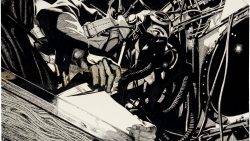
Not only had he crossed the line from fan to professional but he was working toward launching another fan magazine named Outlet, and was art director for Amara, the Robert E Howard fanzine which featured art by Roy Krenkel and George Barr. In CBA Adkins recalled, “That was very early in my career. We got drawings from Frazetta and Krenkel because I knew Roy Krenkel. That’s one reason they made me art editor! It wasn’t for my abilities; it was for who I knew!”
WALLACE WOOD’s PROTÉGÉ: FANTASTIC VOYAGE from T.H.U.N.D.E.R. to WITZEND
Adkins recounted to CBA, “I went up to Wally Wood’s studio (in late 1964 or early 1965). I was working in advertising at the time, and freelancing for professional s-f magazines, and doing art for the regular fanzines. I had no idea of becoming a comic book artist—I was going to be a studio man; but I took out nine pages that I had done for a magazine, a story Jack Gaughan had given me, and a story Archie Goodwin had given me called “The Sinner.” When Wally saw all this stuff, he was impressed, and he said he’d do something for me, but he was busy. He said the sooner I helped him out, the sooner he’d work for my fanzine!”
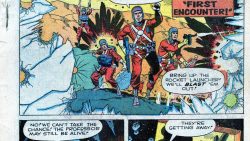 Harry Shorten and his right-hand man Samm Schwartz were important figures in the early days of Archie comics. Shorten hired Wood as a freelance editor-creative director-writer-artist-inker-packager giving Wood nearly unprecedented creative freedom. Tower Comics became a magnet for talent who wanted to work with Wood. Steve Ditko, Chic Stone, Gil Kane, Ralph Reese, Tony Coleman, Tatjana Wood, Reed Crandall, Dick Ayers, Manny Stallman, Len Brown, Dan Adkins, Steve Skeates, Bill Pearson and more were involved. Though a few worked through Samm Schwarz at the Tower office, the vast majority of the super-hero comics were a product of Wood’s studio.
Harry Shorten and his right-hand man Samm Schwartz were important figures in the early days of Archie comics. Shorten hired Wood as a freelance editor-creative director-writer-artist-inker-packager giving Wood nearly unprecedented creative freedom. Tower Comics became a magnet for talent who wanted to work with Wood. Steve Ditko, Chic Stone, Gil Kane, Ralph Reese, Tony Coleman, Tatjana Wood, Reed Crandall, Dick Ayers, Manny Stallman, Len Brown, Dan Adkins, Steve Skeates, Bill Pearson and more were involved. Though a few worked through Samm Schwarz at the Tower office, the vast majority of the super-hero comics were a product of Wood’s studio.
The premier issue of T.H.U.N.D.E.R. Agents (Tower Comics), cover dated November 1965, was Adkins’ first collaboration with Wood and the introduction of the Iron Maiden.
Adkins worked with Wood on about eighteen T.H.U.N.D.E.R. Agents stories, including Dynamo stories. Adkins quickly proved his abilities to Wood and started doing more than Wood’s average assistant. As he told Roy Thomas in CBA, “[Wood] usually broke [layouts for his stories] down on typing paper, and I’d take it from there and do [full-sized] pencils. There were four stories for which I did the layouts myself. The penciling on those, was all mine, and those are the ones I got [published] credit for.” Generally, Wood would finalize the work in ink.

While working for Wood on material published by Tower Comics, what was once Adkins’ planned fanzine, Outlet, became Wood’s and was ultimately published in 1966 as Witzend. By that point, Adkins was working full-time for Wood who, got contributions from his famous pals Al Williamson, Frank Frazetta, and Reed Crandall. So Wood and his people were contributing more than Adkins’ people to the first issue. Adkins told Thomas in CBA that, Wood taking over as publisher also had to do with money. Adkins said he “had enough [money] to publish 500 copies, and Wally had enough to publish 3000 copies… So that’s how come it became Wally’s.”
Adkins also collaborated with Wood, illustrating and writing stories for Creepy and Eerie magazines (Warren), The Munsters, Total War and Fantastic Voyage (Gold Key/Western). Adkins also did work for Warren magazines without Wood.
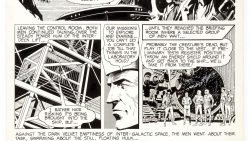
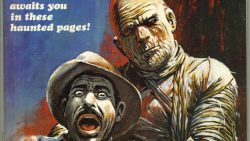
MAKE MINE MARVEL: DRAWING & INKING FOR MARVEL
While working for Wood, Adkins met Jim Steranko. Not long afterward, Steranko landed the Agent of S.H.I.E.L.D. feature in Marvel’s Strange Tales comicbook. As Adkins recalled to J. David Spurlock, Adkins brought it up to Wood saying, “That kid got his own book at Marvel and is getting full credit!” Wood then told Adkins, “Sign your name to that story you’re working on.” And Adkins got more credit from then on but before long he went to visit Marvel too.
Adkins landed the Doctor Strange feature which, along with Steranko’s S.H.I.E.L.D., filled the pages of Strange Tales. Adkins and Steranko were both testing the cultural changes of the ‘60s and it was difficult to know whose feature was more far-out. Steranko recalled, “Dan and I started as rivals. He was Woody’s assistant and I was a Wood imitator. I was visiting Wood one day—in a white linen suit and accompanied by an off-duty Playboy bunny, which alienated the hell out of everybody but Woody! ‘Who the fuck does this guy think he is,’ Adkins told me he’d remarked later. ‘I’m gonna blow him off the map!!!’ And he got the opportunity when we competed in STRANGE TALES. Blowing me away, however, is more easily said than done. He soon acquiesced and I didn’t rub his nose in it (much) and we became tight friends.”
Steranko spent plenty of time at Adkins’ place in Brooklyn. Sometimes he’s ink a panel just for fun. On one visit, Steranko picked up his now legendary Hulk Annual #1 assignment as Adkins was too busy to do it. Surely Adkins’ most famous cover of the era, if not his entire career, came when Strange Tales gave way to Doctor Strange and S.H.I.E.L.D. being promoted to their own books.
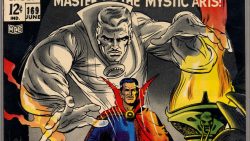
Adkins’ cover to the premier issue of Doctor Strange is an absolute classic. The issue is listed as #169 as it continued the numbering from Strange Tales. Dan had learned to “swipe” images from photos and drawings alike while working with Wood. His cover to X-Men 35 is one such example. In a conversation with Roy Thomas, Adkins cleared up the mystery of the iconic cover. “People give Kirby credit for laying that one out. But he didn’t,” said Adkins to Thomas. “The Spider-Man is a direct swipe from Ditko, just redrawn a little bit. The X-Men figures were all swiped from Kirby.” But Wood used “swiped” reference better than Adkins. Wood used photos or older Golden Age reference art that most readers were too young to recognize and it all came out looking like Wood once rendered in Wood’s magic inking style. Unfortunately, Dan’s swipes were too-often far more recognizable and his reputation took a hit for it.
It quickly became apparent that Adkins would not be able to pencil and ink a full-length book as he had with the smaller 10-page instalments in Strange Tales. That’s when Dan gravitated to inking; quite notably on Doctor Strange, Sub-Mariner, The X-Men, Silver Surfer issues 7-15 and Conan the Barbarian. By the numbers, Adkins worked on 130 covers for Marvel, worked with 70-plus artists and inked 900 comic book stories.
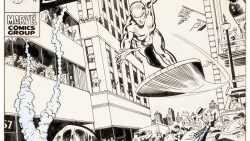
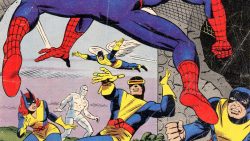
MENTOR & ART DIRECTOR
After being mugged and having his place broken into in New York in the ‘60s, Adkins moved to Ohio for about six years. From Ohio Dan freelanced for Marvel and mentored then-unknown-talents, P. Craig Russell, Val Mayerik and Paul Gulacy. In CBA #7 Gulacy said: “Adkins was one of the most eccentric little men I’ve ever met, but a sweetheart. [Dan] was very knowledgeable. He knew about technique, he was the guy to go to for critique, he was the guy who would tell you what was wrong. He knew everything. [And if he didn’t,] he’d network around [to find out]. He’d call Frazetta in the middle of the night and say, ‘Hey, what did you make on that last job?’ Or he could just call Frazetta and talk about a hangnail on his toe!” Gulacy continued: “[Dan was] terrified of cars. I was third in line in Dan’s Elvis movie escort service, driving Dan to Elvis movie marathons at the local drive-in in East Liverpool, Ohio. Craig [Russell] was first… then he dumped it on [Val] Mayerik, Mayerik wised up, and then I was the third guy in line for this nonsense. Dan would take a big quart of Pepsi and crunch on Cheetos, and that was his dinner. I’ve never seen Dan Adkins eat anything else but Cheetos and drink Pepsi!”
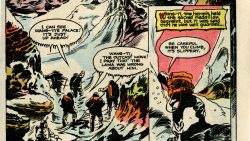
In 1975 Dan moved back to the East, this time to Edgewater NJ, conveniently located just across the river from New York City, between the George Washington Bridge and the Lincoln Tunnel, so he could easily commute to work, full-time at Marvel. For a few years, he served as an Art Director and Consultant, on Marvel’s line of about 15 black and white magazines, including Dracula Lives, Monsters Unleashed, Vampire Tales, Savage Sword of Conan, Tales of the Zombie, Haunt of Horror, Deadly Hands of Kung Fu, Marvel Movie Premiere, etc.
His job included advising, instructing and coordinating with artists and making sure production ran smoothly. Adkins told Thomas: “Anything that needed fixing up, I would do; any talks with the artists about how to correct something, I’d do; and I’d help with designing. After two years, these books stopped selling and they started bringing work from upstairs—on the ninth floor, they put out the men’s magazines, the gossip magazines, and so forth. They started bringing down advertisements for Simon & Schuster that would appear in their books. They were always making changes, and were always so critical. That wasn’t a thing I wanted to do; I’d been spoiled by all the drawing! This is the stuff I used to do in the studios, what they’d call paste-ups.” In that role, Adkins increasingly ceased to be an illustrator and was pushed to doing more design and production work like he had a decade earlier, before working with Wood. Though he liked the steady money, it wasn’t his idea of a good time so, he left Marvel.
DC COMICS
In 1977 Adkins moved over to DC Comics and he was assigned to work with Don Newton on Return of the New Gods and Batman. He also inked Curt Swan on Superman and Dan Jurgens on Warlord into the mid-1980’s.
Adkins’ most memorable work at DC was with Don Newton, whom he had first contacted in 1972 while he worked at Marvel Comics. In 1976, he was teamed up with Newton on New Gods, DC Special #28, and the result was a penciler-inker team that would go on to work on 49 stories, 694 pages. “We were a good team,” said Adkins. “He liked to pencil, and I liked to ink.”
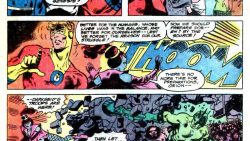
Dan Adkins’ career spanned five decades in the comic book industry, starting as a fan boy in the early 1950’s, working as a penciler, inker, writer, painter, and full-time art-director. In CBA #2, Barry Windsor-Smith said, “Dan was certainly my favorite inker [in my original Conan] period because he meticulously followed my every line. [An example would be Dan’s] excellent job on the story, Black Hound of Vengeance [in Conan #23].” Gil Kane said, “The best inkers I ever had were Dan Adkins, Wally Wood and Kevin Nowlan.” While working with J. David Spurlock on The John Buscema Sketchbook, Buscema said, “I rarely praise inkers because I would have preferred to ink everything myself. But my brother Sal, Joe Sinnott, Frank Giacoia, John Romita, Tom Palmer, Al Williamson and Dan Adkins were all top professionals who did great jobs inking me. And Dan in particular was a fun guy to work with.” Though Adkins’ work helped entertain millions of people, and he helped mentor a new generation, his rich legacy has been, for too-long, under celebrated. It is a very deserving tribute, and with great pleasure, that he is honored now.
He is a worthy member of the Inkwell Hall of Fame.
